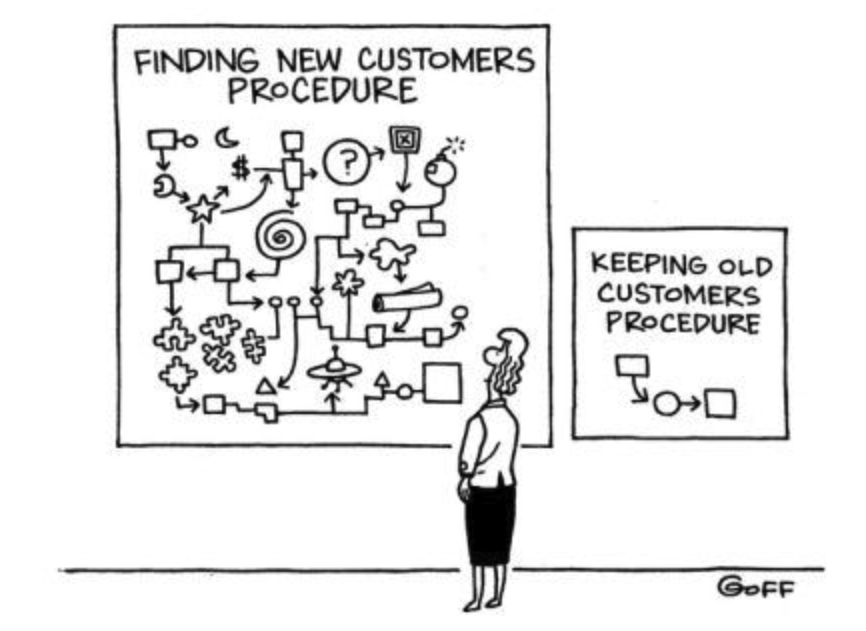As widely reported, there has been a huge boom in ecommerce driven by the ‘new normal’ of the pandemic. According to Mastercard, from early October through Christmas Eve, online retail spending rose 49%.
This huge growth is understandably hailed with great excitement in the ecommerce world. Analysts opine that this is a tipping point, consumers will never go back to their old behaviors and of course, the greatest current cliché of them all, that this is the ‘new normal’.
However, caution is required: it is one thing to catch new customers, but quite another to keep them. Ecommerce and the availability of digital channels do not suddenly break the natural laws of business. There is no requirement or obligation for customers to repurchase or re-subscribe. They switched once; they can switch again. So how do organizations ensure that this newfound ecommerce customer wealth is not frittered away?
Looking at the headline growth number in recent ecommerce trends can be deceptive. It is important to understand the sources of the recent growth. We can break that down in two ways:
- Existing online shoppers buying in new categories. These include categories such as OTC medicines, groceries, alcohol and furniture/appliances which showed gains of up to 44% according to a recent McKinsey study.
- Adoption of new ‘shopping behaviors.’ The same survey reported that 75% of respondents had tried a new online shopping ‘behavior’ during the pandemic. New ‘behaviors’ could include the use of delivery apps, curbside pickup, new stores/sites and different brands.
So in reality, the growth is driven by specific category and use case hot spots which are particularly relevant in the pandemic environment. For example:
- In the Grocery Delivery sector, Instacart reported a 500% jump in order volume, a 35% increase in basket size and a network of over 500 retailers, across nearly 40,000 retail store locations.
- In the Home Furnishings/Appliances category, by May last year, Home Depot reported that its online channel had grown about 80%, with 60% of online orders completed by curbside pickup.
- Meanwhile, app-driven food delivery companies, Uber Eats, Grubhub, DoorDash and Postmates reported a 50%+ rise in combined revenue of $5.5 billion from April through September 2020, more than double that in 2019.
Another important corrective. There has been much written about what a catastrophic year this has been for traditional brick and mortar retailers – certainly the number of retailers filing for bankruptcy and the huge number of store closings has been grim.
What is sometimes overlooked, is that a number of the retailers benefiting most from the flight to eCommerce are in fact traditional brick and mortar brands who have adapted to the insurgent online channel. Names such as Best Buy (online growth of 105%), Target (103.5%) and Home Depot (73%) show that evolution is possible.
As the world returns later this year to something approaching normality, it is inevitable that the growth rates of the past 9 months in these categories will wane. The question that beneficiaries of the COVID eCommerce boom face, is whether they can keep and grow the customers they have acquired and just how they will do that.

So, what are the steps organizations can take to address this question, and what are those to be avoided? We see three areas of opportunity:
- Take your transactional mindset and metrics and find opportunities to embed a more relational approach to your customers
- Use insights to drive emotional relevancy with customers
- Be authentic in efforts to add value, admit failures, and solve customer problems
Transactions vs Relationships
The pressure to acquire new customers tends to fuel a transactional marketing strategy. Tactics and communications are more focused on short-term sales, with a high reliance on one-off promotions and a low customer commitment.
- Existing customers are the greatest source of profitable growth – investing in existing customer relationships should be a no-brainer. A classic piece of research by Frederick Reichfeld and Bain and Company, demonstrated that a 5% increase in customer retention correlates with a 25% increase in profit. In a later study focused on ecommerce, profit rose by 95% in some cases.
- Less reliance on promotions, more focus on building trust and convenience
- Show customers that you understand their needs, and remember their previous interactions
So, it is not just about what a customer bought, when they bought it, or how often they bought it, but why they bought it, maybe how to use it, and why it’s the right choice for them?
Fortunately, the ecommerce channel is rich in transactional and operational data. The sophisticated predictive models and algorithms such data enables, are capable of detecting highly complex behavioral patterns, and to trigger dynamic and individualized messaging based on those patterns.
- Data rich, connection poor: real-time data-driven messaging sounds cool but it is too often one-dimensional, highly promotional (which means cost) and misses the emotional connection with customers.
- Not every communication needs to be a promotion to drive a sale. If it is, customers will start to tune you out and won’t pay attention when you reach out with something that really does add value or convenience to their lives.
Build Emotional Relevancy with Customers
Failure to create an emotional connection is costly. According to research, customers who feel emotionally connected to a brand spend twice as much, tend to have a longer tenure with a brand (5 years vs 3.4 years), and deliver over 300% more in lifetime value. We have a much stronger understanding today of how the brain creates these emotional connections. The key is storytelling. Stories are the bridges that allow customers to connect their own experiences to what they are seeing, hearing or reading. When a story resonates with us emotionally, it has an observable impact on our brains, releasing dopamine, a chemical that helps to lodge it in the memory.
Finding the right stories does not happen by accident though. To do that we need to understand the emotional needs and triggers of customers that underly buying decisions:
- Connecting the what, the how, and the why
- Combine demographic, transactional and customer journey data, with insights from qualitative research to build detailed customer profiles and personas
- Collaborate with creative teams to derive art from the science by using personas as fuel to develop stories that stimulate customer connections. Stay in your brand lane but be bold, content can go much further than the immediate product and service features.
Examples of going beyond basic product or service benefits could include:
- Home Furnishings/DIY – digital planograms that help you choose your paint and furniture
- Grocery – stories can be built online and instore around “choose your meal recipes” for easy to make dinners. Order online or pick up in-store. Grocers will be the next meal delivery winners
- Electronics – a catalog-like online wallet for all your warranties or help with “cutting the cord”
Whatever the creative approach, an insight-based contact and content strategy that builds emotional connections to customers is essential. Make it easy, reassure them, teach them something new, or direct them in an authentic voice anchored in relevance.
Get Serious About Adding Value, Admitting Failure, and Solving Customer Problems
Customer service is the secret weapon in retention, although it is often regarded as a necessary evil. The key imperative has been to drive down cost per contact through any means possible and technology is seen as a critical ally in this battle. Typical tactics include:
- 1-800 phone trees that require customers to endure a full recital of options before pushing a button
- Making ‘contact us’ details hard to find.
- Chat solutions that are really just FAQs with a fancy front-end
However, contact avoidance is not a winning strategy if you want to retain and grow customers. Too many organizations are using technology not to help, but to deflect. As referenced above, a great example of this today is the growth of artificial intelligence (AI) solutions in Chat applications. The ‘intelligence’ element of AI in these tools is generally noticeable by its absence. As soon as chat questions become more nuanced, customers tend to be served with links to the same three or four basic content areas. These are triggered by keywords you may have included in your question such as ‘billing,’ or ‘website’ or ‘support.’ As with pressing ‘0’ during the phone tree loop, sometimes you can trick the system into connecting you with a live agent by typing the words ‘associate’ or ‘live chat’ but that is more by luck than design.
AI technologies do offer some great opportunities to better serve customers and generate efficiencies, but deployment has to be underpinned by a genuine desire to solve their problems. Recent research by Gartner looked at the impact on retention of ‘value enhancing’ vs ‘low effort’ customer service interactions. In this context, the term ‘value enhancing’ signifies an authentic effort to add value and solve problems. A value enhancing interaction could also include providing information on how a customer can get more out of the product or service they have bought. ‘Low effort’ is the appearance of trying to do this but not delivering.
A ‘Value enhancing’ service interaction showed a number of benefits:
- After a ‘value enhancing’ interaction, the average probability that the customer would stay loyal when presented with an opportunity to switch was 82%. That compared with a 61% probability after experiencing a ‘low-effort’ problem resolution.
- 97% chance of positive word of mouth
- 86% likelihood of increased wallet share
This study did not suggest that newer digital self-service channels could not provide value enhancing interactions. The difference was whether customers felt that the organization was genuinely trying to help or not.
Emotional intelligence is critical in the development of the business rules and requirements for these new solutions. As in the broader customer retention communication approach, the insights and skill sets that guide those, should be brought into play here too.
The Takeaway
As the ecommerce channel continues to mature and evolve, a retention strategy will not be a luxury but an essential service. Critical to success will be the understanding that retention is not just a marketing strategy but a business strategy.
Retention won’t be driven through 20% discount offers, or an enhanced mobile app, and certainly not by graying out customer service contact options and hiding the phone number. Sustainable retention will be driven by a deeper understanding of what makes customers tick. It will be driven by the fusion of art and science that turns data and research into stories that spark unique emotional connections. Finally, and most importantly, it will be driven by an authentic desire and true commitment from the organization to do the right thing for the customer.
Ultimately it is simple: a business’s relationship with its customers is not so very different from our relationships with each other. As Maya Angelou put it:
“I’ve learned that people will forget what you said, people will forget what you did, but people will never forget how you made them feel.”



